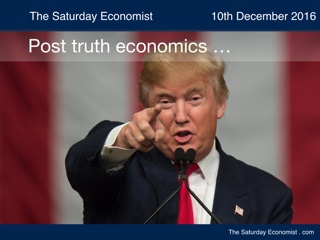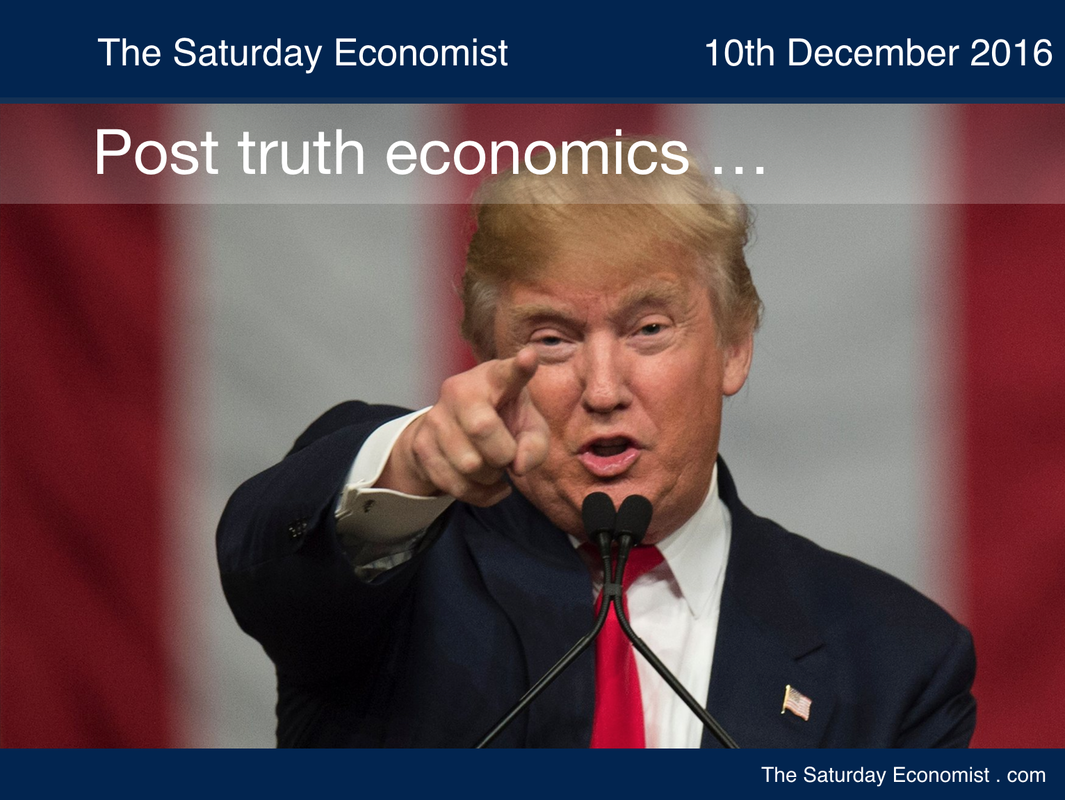 Oxford Dictionaries has declared “post-truth” to be the chosen international word of the year. Use of the term increased by 2,000% in 2016 largely due to the U.S. election and the U.K. referendum. The words of Trump and Farage, of Boris Johnson and the Double Decker Bus pay tribute to the term. “Post-truth” denotes circumstances in which objective facts are less influential in shaping opinion than appeals to emotion and personal belief.” It is hardly a new phenomenon. British philosopher Bertrand Russell said: “If a man is offered a fact which goes against his instincts, he will scrutinise it closely, and unless the evidence is overwhelming, he will refuse to believe it. If, on the other hand, he is offered something which affords a reason for acting in accordance to his instincts, he will accept it, even on the slightest evidence.” JFK would point out, The great enemy of the truth is very often not the lie -- deliberate, contrived and dishonest … but the myth, persistent, persuasive, and unrealistic. Belief in myths allows the comfort of opinion without the discomfort of thought. When presented with information which opposes that which we already believe, the natural reaction is to deny the new information rather than change our behavior or belief. We call this confirmation bias, easier to accept than to challenge. In our research the training is to always revert to basics, to challenge and identify first premise. Back to foundations, testing every statement made, ensuring the evidential is identified to support the hypothesis. Analysis, Analysis, Analysis the mantra. The guideline is as valid for business as it is for academic research. The great challenge on acquisition of any business acquired, was always to identify and expose the “management myths” often the foundation of misguided strategy. Populism and post-truth … Playing to public opinion or populism is a dangerous game to play. A simple message stated with intense frequency is the mode of populist conversion. Making America Great Again, Making Britain Great again, taking back control, reclaiming our borders, build a wall, any wall. We heard so much of this during the Presidential election and the U.K. referendum. Post truth strays to the boundary of “beyond belief” but not further into territory which is easily denied. And what of Globalisation … It is said the referendum result in the U.K. was in part a vote against “globalisation”. Amazing the intelligence derived from one tick or a cross! Most voters myself included would be quite unsure about what is actually meant by the term. Globalisation is a post truth tautology. It certainly is interpreted in different ways. According to a recent speech by Governor Carney in Liverpool. 70% of Chinese workers believe that globalisation creates jobs and increases wages. U.S. workers believe that globalisation leads to job losses and lower wages. A belief exploited on the campaign trail by President-elect Trump to great effect, China and the U.S.A. are at different stages in the manufacturing life cycle. Globalisation reflects the passing of empires ... Globalisation reflects the passing of Empires. In the late 30s, the U.K. exported more manufacturing goods than the USA. Post war period begat the Golden Age of American Manufacturing. By 1953, US manufacturing exports were nearly twice as large as the UK. By the mid 1970s Europe and Japan rebuilt. Japan and Germany were the fast growing players in international trade. By 1976 America’s share of global trade had fallen back to pre war levels. US manufacturing employment has been devastated since 2000. Over the past fifteen years, the manufacturing sector lost 5.3 million jobs. The tokenism represented by the Carrier 800 jobs saved, will not reverse the tectonic shifts in global trends. Don’t blame Mexico. The contribution of south of the border offshoring to the loss of US manufacturing jobs has been modest. According to the Bureau of Economic Analysis, employment in Mexican manufacturing plants owned by US firms increased by just 50,000 from 520,000 in 1999 to 572,000 in 2013. The 800 jobs saved at Carrier represent a tiny fraction, of the 12 million Americans employed in manufacturing. In Indiana, over 500,00 jobs are in the manufacturing sector, a figure that has dropped more than 20 percent since 2000. And what of China … Steve Jobs would say “If you want to build a team find an enemy”. Jobs chosen enemy was first IBM, then Microsoft. Trump’s chosen enemy to receive the invective is China. No need for a war on two fronts, hence a rapprochement with Russia, an olive branch waved to the mailed fist in the East. The zephyr created may push Erdogan to Putin and out of NATO. “Globalisation” or “internationalisation” is not a particularly new phenomenon. The age of empire from the Greeks to the Romans, the rise of China as the middle kingdom. Heroin from India to China, travels along the silk road, the slave trade from Africa to North America and the Caribbean. Bananas and cotton flowing back to Europe on the back of unpaid labour in the colonies. Empires wax and wane. In 1978 China came into the world market, followed by India, Russia, Eastern Europe, Brazil and Turkey. China’s entry into the World Trade Organisation cut the average import tax from 14% to 3% by 2015. China in turn now faces a “hollowing out” of low added value products like textiles to less expensive labour sources in Vietnam and Indonesia. The cycle continues. Globalisation is a process of sharing wealth. If we are to avoid the nightmare of economic refugees from North Africa drowning in the Mediterranean, we must do more to deal with income inequality between North and South across the globe. Otherwise the Mediterranean will become the equivalent of the mediaeval moat, protecting fortress Europe from the raving hordes of the North African shoreline. Post truth economics … The post truth phenomenon is just as valid in economics. So much of contemporary theory is derived from emotion and belief drawn from theoretical indoctrination at an early stage. As early students of economics, much of the theory just didn’t make sense. We were urged to learn “parrot fashion”, no time to challenge if we were to be afforded the time to cram. So today, too many are ready to accept the concepts of the meandering NAIRU, the J curve and the alleged positive impact of depreciation on the U.K trade balance. Life on Planet ZIRP is creating a crisis for capitalism. Low interest rates are mis pricing capital in a capitalist world. Central bankers may believe the equilibrium real interest rate is falling as a result of geo demographics, lower growth and an excess of savings over investment. Central banks set rates. Little heed is paid to the trillions of dollars, euros and pounds squandered on the acquisition of government bonds in the U.S. Europe and the U.K. Central banks drive up prices and drive down yields. Creating "the biggest bond price bubble in history". Low yields may beguile borrowers, they damage savers and exacerbate pension fund deficits. Flight to safety ... The Governor may believe institutions are buying gilts at low rates in a “flight to safety”. This is a central bank post truth. Institutions buy as a statutory obligation to cover future liabilities. Ironically, as yields fall, they are obliged to buy more. There can be little capital safety in an overpriced asset. It was James Carville in the Clinton administration who said “I used to think if there was reincarnation, I wanted to come back as the president or the Pope. But now I want to come back as the bond market. You can intimidate everybody.” In the current cycle, it is the bond markets, intimidated by the actions of the central banks. The “shock and awe” tactics of QE are paralysing perceptions of how bond markets really work. U.K. gilts issued by the Debt Management Office, bought by the Bank of England, underwritten by HM Treasury, yields paid refunded, is not the way it is supposed to work. The wake up call is coming as U.S base rates start to rise. U.S. bond yields have risen to 2.4%. They are set to rise further in 2017. And what of Trump in the White House? Trumpeter economics will push up growth along with inflation, interest rates and bond yields. The U.S. national debt is set to rise to over 100% of GDP. We know the Trump business empire has experience of managing debt. Some stylists may think the President-elect needs a haircut. The same cannot be said of U.S. bond markets. “No. I don’t want to renegotiate the bonds. But I think you can do discounting, I think, you know, depending on where interest rates are, I think you can buy back. You can – I’m not talking about with a renegotiation, but you can buy back at discounts, you can do things with discounts. …I would refinance debt. I think we should refinance longer-term debt.” – Donald Trump, 10 May, 2016. [My thanks to the M&G Bond Vigilantes] What then of the flight to safety? The reaction of the bond markets would render the taper tantrum a mere storm in teacup. Let someone Twitter about that. That's not a post truth, more of a promise!
0 Comments
Leave a Reply. |
The Saturday EconomistAuthorJohn Ashcroft publishes the Saturday Economist. Join the mailing list for updates on the UK and World Economy. Archives
July 2024
Categories
All
|
| The Saturday Economist |
The material is based upon information which we consider to be reliable but we do not represent that it is accurate or complete and it should not be relied upon as such. We accept no liability for errors, or omissions of opinion or fact. In particular, no reliance should be placed on the comments on trends in financial markets. The presentation should not be construed as the giving of investment advice.
|
The Saturday Economist, weekly updates on the UK economy.
Sign Up Now! Stay Up To Date! | Privacy Policy | Terms and Conditions | |

 RSS Feed
RSS Feed